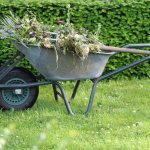To put down lawn fabric, start by clearing and leveling the area, removing any grass or debris. Measure your space, then cut and lay the fabric flat, overlapping edges if needed. Secure it with landscape staples every 12-18 inches to keep it from shifting. Trim any excess fabric and cover it with mulch or topsoil to protect it and enhance weed control. Keep an eye on the fabric’s condition and fix any issues promptly—there’s more to learn for lasting results.
Table of Contents
Key Takeaways
- Clear and level the lawn area by removing grass, weeds, rocks, and debris before laying the fabric.
- Measure the area accurately, cut fabric with sharp scissors, and overlap pieces by a few inches for coverage.
- Lay the fabric flat without wrinkles, starting from one edge and smoothing as you unroll it over the soil.
- Secure the fabric using landscape staples or U-shaped pins every 12 to 18 inches along edges and seams.
- Regularly inspect and maintain fabric tightness, repair tears promptly, and manage weeds to ensure effective weed control.
Choosing the Right Lawn Fabric
How do you pick the best lawn fabric for your garden? Start by considering the fabric’s durability and breathability. You want a material that blocks weeds effectively but still lets water and air reach your soil.
Look for woven fabrics made from polypropylene or polyester—they’re strong and long-lasting. Avoid plastic sheeting; it traps moisture and harms plant roots.
Choose woven polypropylene or polyester fabrics for strength and durability; skip plastic sheeting to protect your plant roots.
Also, check the fabric’s UV resistance, especially if your garden gets full sun. A UV-resistant fabric will last longer without breaking down.
Finally, think about the fabric’s weight and thickness. Heavier fabrics offer better weed control but might be harder to work with. Choose one that balances ease of installation with functionality so your garden thrives without unwanted weeds taking over.
Preparing the Area for Installation
Before laying down lawn fabric, you’ll need to clear and level the area thoroughly. Start by removing any existing grass, weeds, rocks, and debris to create a clean surface.
Use a garden rake or hoe to loosen the soil and guarantee it’s smooth. If the ground is uneven, fill low spots with soil and compact it to prevent sinking later.
Check for any sharp objects that might damage the fabric and remove them. It’s also a good idea to water the soil lightly; moist soil compacts better and supports the fabric firmly.
Taking these steps will help the lawn fabric lie flat and function effectively, reducing the chance of wrinkles or gaps that could let weeds through. Proper preparation sets a solid foundation for your installation.
Measuring and Cutting the Fabric
Once the area is clean and level, you can move on to measuring the lawn fabric to fit your space accurately. Start by grabbing a tape measure and noting the length and width of the area. Remember, it’s better to add a few extra inches on each side to guarantee full coverage.
Measure your lawn area carefully, adding extra inches for complete fabric coverage.
Lay the fabric out flat on a clean surface before cutting to avoid any wrinkles or folds.
Keep these tips in mind when measuring and cutting:
- Measure twice to avoid mistakes
- Mark the fabric with chalk or a fabric marker
- Use sharp scissors or a utility knife for clean cuts
- Cut slowly and steadily to maintain straight edges
Laying the Fabric Over the Soil
After cutting the fabric to size, you’ll want to lay it carefully over the soil, ensuring it lies flat without wrinkles or gaps. Start at one edge and unroll the fabric slowly, smoothing it as you go.
Check that the entire area is covered, overlapping sections by a few inches if you’re using multiple pieces. Pay attention to any slopes or uneven spots, adjusting the fabric so it conforms closely to the ground.
Avoid stretching the material too tight, as this can cause tears or lifting later. If you encounter obstacles like plants or rocks, cut the fabric neatly around them to maintain coverage.
Taking your time here sets the stage for effective weed control and a neat, professional finish.
Securing the Fabric in Place
Laying the fabric smoothly over the soil sets a solid foundation, but you’ll need to secure it to keep it in place. Without proper anchoring, wind or foot traffic can shift the fabric, ruining your efforts.
To secure the fabric effectively, follow these tips:
- Use landscape staples or U-shaped pins every 12 to 18 inches along the edges and seams.
- Anchor the fabric firmly at corners and overlap sections to prevent movement.
- Press the staples deep enough so they don’t stick out and cause hazards.
- Add extra pins around areas prone to disturbance, such as pathways or garden beds.
Trimming Excess Fabric
Trim any excess fabric carefully to guarantee a neat fit and prevent tripping hazards. Use sharp scissors or a utility knife to cut along the edges, following the shape of your garden bed or lawn.
Make sure you leave a small margin—about an inch—beyond the secured area to avoid fabric pulling away over time. Work slowly and steadily, especially around curves and corners, to maintain clean lines. Avoid jagged cuts that can fray and weaken the fabric.
Once trimmed, check that the fabric lies flat without wrinkles or folds, as these can cause uneven ground and affect plant growth. This step assures your lawn fabric looks professional and stays effective for years to come.
Adding Mulch or Topsoil
Once you’ve secured the lawn fabric, it’s time to add mulch or topsoil to protect it and improve appearance.
You’ll want to pick the right material and spread it in an even layer, keeping thickness guidelines in mind.
Applying it carefully guarantees your fabric stays in place and your lawn looks great.
Choosing the Right Material
Selecting the right material to cover your lawn fabric is essential for its effectiveness and appearance. Choosing between mulch and topsoil depends on your garden’s needs and aesthetic preferences.
Mulch offers excellent weed suppression and moisture retention, while topsoil supports plant growth and blends naturally into your landscape.
Consider these options when deciding:
- Organic mulch: Enhances soil health as it decomposes.
- Rubber mulch: Durable and low-maintenance but less natural.
- Topsoil: Ideal for planting areas, improves soil quality.
- Gravel or stone: Provides drainage and a clean look but doesn’t aid soil.
Pick a material that suits your climate, garden type, and maintenance level to guarantee your lawn fabric lasts and looks great.
Layer Thickness Guidelines
Although choosing the right material is essential, applying the correct layer thickness over your lawn fabric is just as important to guarantee proper weed suppression and soil health.
Generally, you’ll want to add a 2 to 3-inch layer of mulch or topsoil. This thickness is enough to block sunlight, preventing weeds from sprouting through the fabric. It also helps protect the fabric from damage caused by foot traffic and weather exposure.
Avoid piling the material too thickly, as it can suffocate the grass roots or cause water drainage problems. Conversely, a layer that’s too thin won’t effectively suppress weeds and might expose the fabric to wear.
Sticking to this guideline guarantees your lawn remains healthy and your fabric performs at its best.
Application Techniques and Tips
When you’re ready to add mulch or topsoil over your lawn fabric, spread it evenly to maintain consistent coverage. This layer protects the fabric from UV rays and helps retain moisture, promoting healthy plant growth.
Here are some tips to get it right:
- Use a rake or shovel to distribute mulch or soil evenly, avoiding clumps.
- Keep the layer thickness between 1 to 3 inches to prevent fabric exposure or suffocation.
- Choose organic mulch like wood chips or bark for better soil health.
- Water lightly after spreading to help the material settle and reduce displacement by wind.
Maintaining the Lawn Fabric
To keep your lawn fabric effective, you’ll need to regularly check it for tears, dirt buildup, and any areas where grass might be pushing through.
Clear off debris like leaves and sticks to prevent moisture retention, which can degrade the fabric. If you notice small tears, patch them promptly with similar material and landscape staples to maintain coverage.
Remove debris regularly to prevent moisture buildup and repair small tears quickly to protect lawn fabric integrity.
Avoid walking heavily on the fabric to reduce wear and tear. Periodically lift edges to ascertain soil hasn’t shifted underneath, which could cause gaps.
Keep an eye on the fabric’s condition, especially after storms or heavy winds, and make minor adjustments as needed to keep it taut.
Proper maintenance extends the fabric’s lifespan, helping you control weeds and protect your lawn effectively.
Troubleshooting Common Issues
If you run into problems with your lawn fabric, addressing them quickly will save you time and effort down the road. Common issues include fabric shifting, weed growth, water pooling, and fabric tearing.
To troubleshoot effectively, try these tips:
- Make sure the fabric is securely anchored with stakes or pins to prevent shifting.
- Inspect regularly for weeds poking through; remove them promptly and consider adding mulch.
- Check for water pooling; improve drainage by adjusting soil grade or adding drainage channels.
- Repair tears immediately with patch kits or replace damaged sections to maintain barrier integrity.
Frequently Asked Questions
Can Lawn Fabric Be Used Under Artificial Turf?
Yes, you can use lawn fabric under artificial turf to prevent weeds from growing through. You’ll want to lay it flat, secure it properly, and guarantee good drainage to keep your turf looking great and lasting longer.
How Long Does Lawn Fabric Typically Last?
You can expect lawn fabric to last around 5 to 10 years, depending on quality and exposure to elements. Over time, it may degrade, so regular checks help you maintain its effectiveness.
Is Lawn Fabric Safe for Pets and Children?
You’ll find most lawn fabrics are safe for pets and children since they’re made from non-toxic materials. Still, you should avoid ingestion and monitor play areas to prevent accidental chewing or digging through the fabric.
Can Lawn Fabric Prevent Weed Growth Completely?
Think of lawn fabric as a sturdy gatekeeper; it blocks many unwanted guests but can’t stop every determined weed from sneaking through cracks or edges. You won’t get complete prevention, but it greatly reduces growth.
What Tools Are Best for Cutting Lawn Fabric?
You’ll want sharp scissors or a utility knife for clean, precise cuts. A measuring tape helps guarantee accuracy, while garden gloves protect your hands. These tools make cutting lawn fabric easier and more efficient.
- Tetron Fabric for Marine Applications: Durability and Use Cases - June 18, 2025
- Tetron Fabric for Outdoor Furniture: Weather Resistance and Care - June 18, 2025
- Tetron Fabric for Wall Coverings: Style and Application Tips - June 18, 2025







